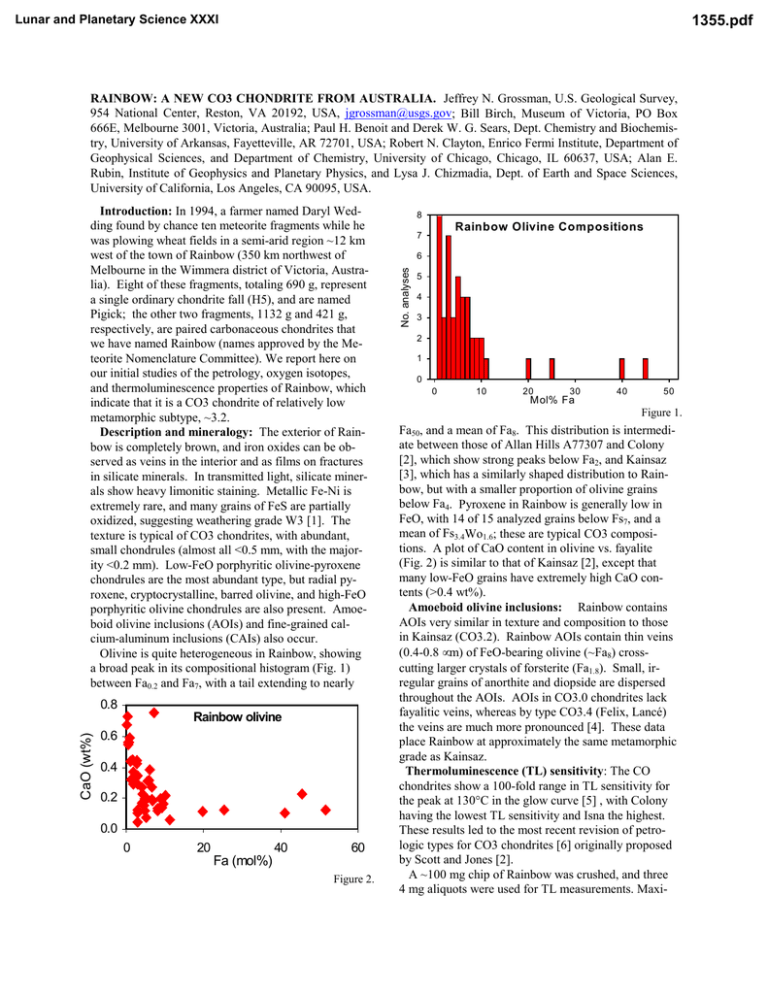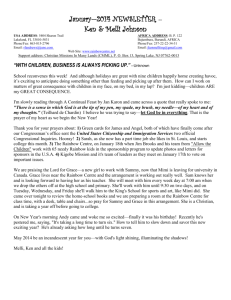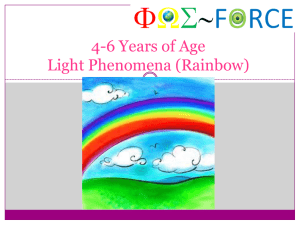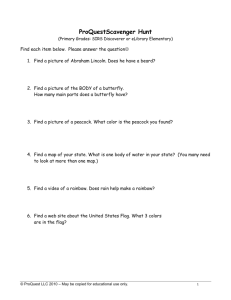RAINBOW: A NEW CO3 CHONDRITE FROM AUSTRALIA.
advertisement

Lunar and Planetary Science XXXI 1355.pdf RAINBOW: A NEW CO3 CHONDRITE FROM AUSTRALIA. Jeffrey N. Grossman, U.S. Geological Survey, 954 National Center, Reston, VA 20192, USA, jgrossman@usgs.gov; Bill Birch, Museum of Victoria, PO Box 666E, Melbourne 3001, Victoria, Australia; Paul H. Benoit and Derek W. G. Sears, Dept. Chemistry and Biochemistry, University of Arkansas, Fayetteville, AR 72701, USA; Robert N. Clayton, Enrico Fermi Institute, Department of Geophysical Sciences, and Department of Chemistry, University of Chicago, Chicago, IL 60637, USA; Alan E. Rubin, Institute of Geophysics and Planetary Physics, and Lysa J. Chizmadia, Dept. of Earth and Space Sciences, University of California, Los Angeles, CA 90095, USA. 0.8 CaO (wt%) Rainbow olivine 0.6 0.4 0.2 0.0 0 20 40 60 Fa (mol%) Figure 2. 8 Rainbow Olivine Compositions 7 6 No. analyses Introduction: In 1994, a farmer named Daryl Wedding found by chance ten meteorite fragments while he was plowing wheat fields in a semi-arid region ~12 km west of the town of Rainbow (350 km northwest of Melbourne in the Wimmera district of Victoria, Australia). Eight of these fragments, totaling 690 g, represent a single ordinary chondrite fall (H5), and are named Pigick; the other two fragments, 1132 g and 421 g, respectively, are paired carbonaceous chondrites that we have named Rainbow (names approved by the Meteorite Nomenclature Committee). We report here on our initial studies of the petrology, oxygen isotopes, and thermoluminescence properties of Rainbow, which indicate that it is a CO3 chondrite of relatively low metamorphic subtype, ~3.2. Description and mineralogy: The exterior of Rainbow is completely brown, and iron oxides can be observed as veins in the interior and as films on fractures in silicate minerals. In transmitted light, silicate minerals show heavy limonitic staining. Metallic Fe-Ni is extremely rare, and many grains of FeS are partially oxidized, suggesting weathering grade W3 [1]. The texture is typical of CO3 chondrites, with abundant, small chondrules (almost all <0.5 mm, with the majority <0.2 mm). Low-FeO porphyritic olivine-pyroxene chondrules are the most abundant type, but radial pyroxene, cryptocrystalline, barred olivine, and high-FeO porphyritic olivine chondrules are also present. Amoeboid olivine inclusions (AOIs) and fine-grained calcium-aluminum inclusions (CAIs) also occur. Olivine is quite heterogeneous in Rainbow, showing a broad peak in its compositional histogram (Fig. 1) between Fa0.2 and Fa7, with a tail extending to nearly 5 4 3 2 1 0 0 10 20 30 Mol% Fa 40 50 Figure 1. Fa50, and a mean of Fa8. This distribution is intermediate between those of Allan Hills A77307 and Colony [2], which show strong peaks below Fa2, and Kainsaz [3], which has a similarly shaped distribution to Rainbow, but with a smaller proportion of olivine grains below Fa4. Pyroxene in Rainbow is generally low in FeO, with 14 of 15 analyzed grains below Fs7, and a mean of Fs3.4Wo1.6; these are typical CO3 compositions. A plot of CaO content in olivine vs. fayalite (Fig. 2) is similar to that of Kainsaz [2], except that many low-FeO grains have extremely high CaO contents (>0.4 wt%). Amoeboid olivine inclusions: Rainbow contains AOIs very similar in texture and composition to those in Kainsaz (CO3.2). Rainbow AOIs contain thin veins (0.4-0.8 µm) of FeO-bearing olivine (~Fa8) crosscutting larger crystals of forsterite (Fa1.8). Small, irregular grains of anorthite and diopside are dispersed throughout the AOIs. AOIs in CO3.0 chondrites lack fayalitic veins, whereas by type CO3.4 (Felix, Lancé) the veins are much more pronounced [4]. These data place Rainbow at approximately the same metamorphic grade as Kainsaz. Thermoluminescence (TL) sensitivity: The CO chondrites show a 100-fold range in TL sensitivity for the peak at 130°C in the glow curve [5] , with Colony having the lowest TL sensitivity and Isna the highest. These results led to the most recent revision of petrologic types for CO3 chondrites [6] originally proposed by Scott and Jones [2]. A ~100 mg chip of Rainbow was crushed, and three 4 mg aliquots were used for TL measurements. Maxi- Lunar and Planetary Science XXXI 1355.pdf RAINBOW: J. N. Grossman et al. CO3 Chondrites 0 Rainbow -1 TF -2 -3 δ17Ο mum TL intensity (sensitivity) was normalized to that of a sample of Dhajala. Samples of Colony (CO3.0) and Isna (CO3.7) were measured at the same time and under the same conditions. Samples of Rainbow exhibit two induced TL peaks at 140±10°C and 370±20°C, with TL sensitivities of 0.014±0.002 and 0.014±0.001, respectively, relative to Dhajala = 1.0 (uncertainties are 1-σ for the three aliquots). Samples of Colony and Isna exhibit TL properties in accord with previous data [5]. The intensity ratio of the two induced TL peaks in Rainbow is ~1.0. Rainbow exhibits induced TL properties very similar to Colony, although Colony lacks the pronounced peak at 140°C. Based only on TL sensitivity, Rainbow would be assigned to a petrologic type 3.0, as was Colony. However, the prominence of the 140°C peak in the glow curve of Rainbow is more similar to the glow curves of type 3.1-3.2 CO chondrites. It is likely that the TL sensitivity of Rainbow reflects terrestrial weathering in addition to parent-body metamorphism, in analogy to effects noted in the TL data of unequilibrated ordinary chondrites (e.g., [7]). Therefore, the TL data are supportive of a type assignment of 3.1-3.2. Oxygen isotopes: Oxygen isotope analysis was done on a 5 mg whole-rock sample of Rainbow. The measured O-isotope composition is δ18O = +2.05‰, δ17O = −2.74‰ relative to SMOW. This composition is plotted along with data from other CO3 chondrites [8] in Fig. 3, with the terrestrial fractionation (TF) and carbonaceous chondrite anhydrous minerals (CCAM) lines shown for reference. Rainbow has a heavier Oisotopic composition than any previously measured CO3 chondrite. Nevertheless, it falls precisely on the regression line of slope ~0.66 passing through the CO3s [8]. The oxygen data clearly support classification of Rainbow as a CO chondrite. Rubin [9] suggested that there is a rough correlation between O-isotopic composition and metamorphic grade in the CO3 chondrite group. If Rainbow is subtype ~3.2, as implied by its mineralogy and TL properties, then its O-isotopic composition plots far from those of other CO3s of similar metamorphic grade (e.g., ALHA 77307 and Kainsaz, Fig. 3), and the correlation noted in [9] is destroyed. However, terrestrial weathering may also affect Oisotopic compositions. The two lightest compositions among CO3s measured by [8] belong to the only two Antarctic finds, whereas the two heaviest belong to Saharan finds. Other Saharan finds plot with observed falls in a narrow range of compositions spanning ~2‰ in δ18O. Rainbow, like the Saharan specimens, was weathered in a hot, arid environment. Weathering of ordinary chondrites in Saharan and Australian deserts enriches heavy O isotopes, in some cases by >2‰ in -4 A77307 -5 Kainsaz -6 Antarctic find -7 AM CC -8 -5 -4 -3 Saharan find Fall -2 -1 δ18Ο 0 1 2 3 Figure 3. δ O, presumably due to in situ oxidation of metal and sulfide [10]. At weathering grade W3, Rainbow has lost most of its metal and much of its sulfide. Kainsaz, the fall to which Rainbow is most similar, contains 5.9 vol% metal [11], similar to the L-group abundance. Thus, weathering of Rainbow might produce similar isotopic effects as weathering L chondrites. We tested this possibility by acid-washing a split of Rainbow to remove terrestrial weathering products. This did not produce a large change in O isotopes (δ18O decreased by < 1‰), still leaving Rainbow as one of the isotopically heaviest CO3 chondrites. We are forced to conclude that there is not a significant correlation between O isotopes and metamorphic grade. Conclusions: Rainbow is a weathered CO3 chondrite. Its metamorphic grade resembles that of Kainsaz (3.2), although it may be a bit less metamorphosed than Kainsaz. Combining our results for olivine composition, TL and AOIs leads us to conclude that Rainbow’s subtype is 3.1-3.2. Oxygen isotopes confirm Rainbow as a member of the CO chondrite group. It breaks the correlation between O-isotopic composition and metamorphic grade, although weathering may affect some of the O data. References: [1] Wlotzka (1993) Meteoritics 28, 460. [2] Scott and Jones (1990) GCA 54, 2485-2502. [3] Van Schmus (1969) in Meteorite Research (Millman, Ed.) 480-491. [4] Chizmadia and Rubin (2000), this volume. [5] Keck and Sears (1987) GCA 51, 30133021. [6] Sears, Batchelor, Lu and Keck (1991) Proc. NIPR Symp. Antarct. Meteorites 4, 319-343. [7] Benoit and Sears (1999), JGR 104, 14159-14168. [8] Clayton and Mayeda (1999) GCA 63, 2089-2104. [9] Rubin (1997) MAPS 32, A110-A111. [10] Stelzner et al. (1999) MAPS 34, 787-794. [11] McSween (1977) GCA 41, 477-491. 18





